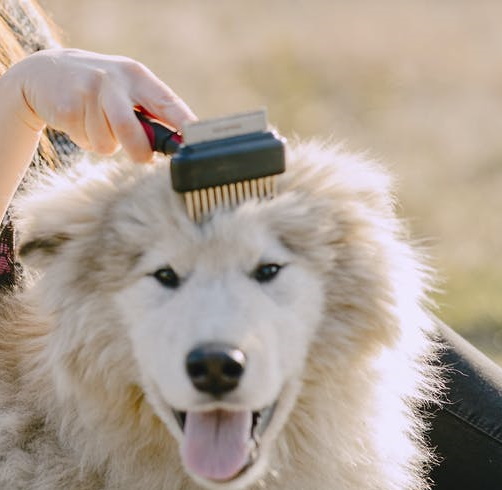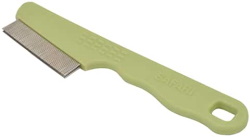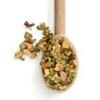How To Get Rid Of Dog Fleas
- The Ultimate Battle Plan!
Getting rid of dog fleas can be an overwhelming task. But don’t worry! With a natural, gentle approach, you can fight back and get your pup flea-free in no time. Let’s dive into the battle plan and reclaim your dog’s comfort.

Signs Your Dog Has Fleas
How do you know if your dog has fleas? Well the most obvious sign is that you see a flea jump off your dog or you spot an embedded tick on his body, but before that happens, here are some other telltale signs:
- Sudden increase in scratching and chewing
- Patches of dry skin
- Dandruff or flakes
- Hair loss, often in patches
- Flea Dirt on the skin
- Flea eggs on the skin
- Evidence of flea or tick bites
If any of these signs look familiar, your dog might have fleas. Let’s catch them early and take action!
Finding the Fleas
You've no doubt heard the expression "breeding like rabbits". Well that should more aptly be changed to fleas.
The rabbits have nothing on them in the breeding department. Just a drop in the bucket - which, by the way, is where the fleas and eggs should go after you have combed them out of your dog's coat - a bucket of soapy water that is.
Here's how to track them down:
- Flea Dirt: Use a dry fine-toothed flea comb and run it through your dog’s coat (focus on the back and belly). Do this over a white surface, or white paper, so you can spot the black specks. When you squish them, if they turn brownish-red, they’re flea droppings (yuck!).
If your dog has been attacked by fleas, then they are in your home also. Sorry!
While fleas may tend to jump on and off their host, the eggs they lay on a pet's coat usually fall off into areas he frequents.
- Fleas in the House: Look for flea eggs in your dog's favorite spots—like their bed, your couch, or carpeted areas.
You may need a magnifying glass and some dark paper to identify them as they resemble tiny grains of oval-shaped salt.
But, these eggs can hatch in a matter of days and keep the flea cycle going, so it's crucial to
interrupt their life-cycle
to get them gone!
So let's get to it.

Get Rid of Dog Fleas Step By Step
When it comes to planning an attack to get rid of dog fleas, the natural control method is a three step approach involving:
- The dog,
- The home and
- The outside environment
- all of which need to be
treated at more or less the same time to solve the problem.
While popular spot-on treatments may work to get rid of dog fleas, they do rely on pretty strong chemicals that have been known to cause health problems. Just a peek at the the label warnings is pretty scary. The point being - these products are toxic!
When shopping for more natural pest control products look for some of these items on the labels:
cedarwood, mint, vinegar, clove oil, citrus, lemongrass oil, and rosemary oil.
You'll probably notice that these all have strong scents, which coincidentally are ones that parasites hate.
Natural flea control methods provide safer alternatives when it comes to
getting rid of fleas and that's the approach I prefer to use. If you like this idea, keep reading.
Treat Your Pets First
A healthy dog has a lot more natural immunity to a flea attack. Diet is so important to a dog's health, that the biggest favor you can do for your dog is to feed him high quality dog food!
Not only will this provide the nutrients for a strong immune
system, it will also help your dog avoid skin problems that weaken
the skin and make it very attractive to parasites.
- Start with a daily dose of brewers yeast
which will make your pet's skin distasteful to fleas. The recommended amount is 1/2 teaspoon per 10 pounds of body weight. Check with your vet before giving this to your pet as he knows your dog's health profile the best.
- Boost your dog's immune system with a premier supplement like Missing Link so that he has better defense against flea attacks.
- Add essential fatty acids to provide extra support for skin health.
Grooming Tips
- When fighting an infestation, comb your dog daily (outside) with a flea comb. Dip a fine-toothed flea comb in a bucket of soapy water first - this will prevent the fleas from escaping while you comb them out and deposit back in the water. This will also be a good time to look for ticks.
-
Bathe your dog with a natural flea protection shampoo.
Begin the bath by wetting your dog's head and lathering the neck area
first, letting the product settle for a few minutes before
moving on to the torso.
This cuts off an escape route to the ears and face as you shampoo the rest of the body.
- Apply an all-natural flea and tick control product for ongoing protection.
- For longer term use, consider a botanical collar which safely repels ticks and fleas for five months.
DIY Flea Powder: If you're a DIY enthusiast, try making your own flea powder using dried herbs. Here's how:
Combine one part each of the following dried herbs, either powdered or dried leaves.
- Eucalyptus
- Rosemary
- Fennel
- Yellow dock
- Thyme
- Rue
If using leaves, grind them to a powder using a mini blender, or a mortar and pestle.
- Place the herbal blend in a shaker jar, or empty large spice jar like one used for parsley.
- Begin the application outside away from areas your dog frequents.
- Sprinkle lightly on your dog's coat and brush in a backward motion with your hand. Concentrate on getting the powder at the base of the hairs.
- If the cooties are pretty bad, do this daily.
All of the dried herbs can be purchased in bulk, for economy, at various online stores including Amazon, Mountain Rose Herbs, Vitacost and more. Don't worry if you can't find them all.
Protection For Home And Yard
While you're treating your dog, don’t forget your home and yard. Fleas love hiding in the nooks and crannies of your house, so let’s kick them out for good:
- Wash dog bedding in hot soapy water to get rid of fleas.
- Buy the best vacuum you can afford and run it through every corner of your home paying special attention to your dog's favorite spots. Vacuuming is so important for getting rid of fleas and their eggs in your home - do it daily as long as fleas are present.
- Wrap vacuum bag or canister contents into a separate plastic bag each time you vacuum, seal and discard to
outside garbage container. While being vacuumed will likely kill the fleas, why take chances with any survivors!
- Apply a safe flea and tick control product such as
Fleabusters everywhere around the inside of your house. This is a great product.
- For the outside areas of your house and yard - especially in shady moist areas, or where your pets
like to lie, use a product containing diatomaceous earth. (Not the kind for pool filters)
This amazingly effective all natural very fine powder is made from fossilized skeletal remains of algae-like plants. The powder particles - much like talcum to look at - have incredibly sharp edges which destroy a flea's protective coating and dehydrates them resulting in death.
- Obtain some beneficial nematodes to get rid of fleas around the yard, the lawn and in flower and vegetable gardens. These microorganisms which consume flea larvae, are harmless
to pets, plants or humans. They are also very helpful in destroying
other plant-destructive
insects in the soil.
- Grass lawns should be kept short and watered often. Short grass permits sunlight to warm the soil, effectively killing larvae and water will drown maturing fleas.
- Some insects enjoy a meal of flea eggs and larvae, disgusting as it sounds. Ants are one of them. While you may not want ants close to your house, allowing some outside to help out with flea control is a consideration.
Small changes to your routine will make a big difference in the long run.
Dealing With Ticks on Dogs
Ticks can be just as troublesome as fleas and carry a host of diseases, including lyme disease, which can be transmitted to dogs. Ticks like to hang out in grassy fields or wooded wilderness areas, but dog parks and even areas your own back yard are also potential habitats.
- Check regularly: After walks, check your dog from top to bottom - literally - in search of them! Ears and neck are frequent targets but so are natural skin folds - such as where legs meet body or between toe pads.
- Remove ticks: When you find ticks on dogs, they must be removed right away by pulling straight out with a pair of tick tweezers and flushed down the toilet. Sometimes you may be able to find them before they have become embedded.
- Yard maintenance: There are simple steps
you can take to make your yard less attractive to ticks. Keep grass trimmed, weeds under control, and bushes well-groomed. Ticks like to climb tall plants and wait to latch on to a passing pet or human.
- Ticks require a certain level of humidity to
survive and may be attracted to shaded areas of your yard where
moisture, leaves or other debris accumulates.
The solution: Rake up these areas and cover with black plastic on a hot, sunny day. The heat generated under the plastic will kill any fleas or larvae.
Don't do this if there are plants that you want to protect. Instead, just clean up any dead plant matter and let the ground dry out. This will make it less hospitable to ticks and eliminate another potential habitat or a place to deposit their eggs.
Ticks may also crawl up your house and lay in wait under window sills and other crevices, so filling cracks and similar hiding places is another preventative measure.
To get rid of fleas and ticks using a natural approach may take a little
longer to work, but your pet's health is the top priority when dealing with parasites. When you see a flea product for sale that carries this warning "avoid contact with hands", run!
Be vigilant—ticks can be tricky!
Keeping Fido Flea Free
Once you’ve kicked the fleas out, it’s all about maintaining flea-free habits:
- Buy washable bedding and launder often in hot water.
- Outdoor treatment: Continue treating outdoor areas with flea control products until the first frost. Regular outdoor treatment is especially important to combat any unwanted fleas that may be left by visiting neighbor dogs.
- Cedar bedding: Consider bedding with cedar fill, known for its stellar flea-repellent properties. Also, a cedar dog house if your dog is outside a lot.
- Check for signs of tapeworms - look for rice-like grains in your dog's feces and seek help
right away if you see any.
- Make a skin toner/parasite repellent. Here's how: Cover a thinly sliced unpeeled lemon with a pint of boiling water and let steep for 12 hours. Use the solution in a spray bottle to apply daily to your dog's skin and let dry. The active ingredient in the solution is d-limonene, a natural flea repellent, plus other healing substances found in the lemon.
Fleas Are Persistent, But So Are You!
Dog fleas - aargh. They are a menace for both pets and people and once they check in, they are hard to check out.
Fleas and ticks have been around for millions of years - if you have a dog, spoiled or otherwise,
sooner or later you will encounter them. And what's worse, these cooties are
strong survivors so you have to be very diligent to protect your pet from them.
It only takes a few female fleas a very short time to multiply into a staggering colony if their eggs are
not destroyed.
And while an adult flea can't live but a few days without a meal, fully developed fleas can remain inside the pupal cocoon for several months without eating - just lying in wait for an innocent food source - host - to come their way.
Regular treatments and flea checks will make sure your dog stays comfortable, happy, and flea-free.
Bottom Line
It's an ongoing process to get rid of dog fleas as long as you have furry companions in your home.
Pro Tip - For a periodic flea check on the inside of your home: Put out a flea trap - this one is a popular choice and gets rid of them without the use of chemicals. You'll get the jump on them so to speak and be able to attack the problem before it gets worse!
Fleas are persistent little creatures, but with patience and natural treatments, you’ll have the upper hand. Regular grooming, home cleaning, and outdoor treatment are key to maintaining a flea-free environment.
Whatever products you select to get rid of dog fleas and help your pet with other parasites, make sure to precisely follow the label directions for use.
And, please keep an eye on your dog for any allergic or adverse reaction. Even dog flea products that are regarded as very safe for most dogs, may cause an unwanted reaction in some dogs.
For severe flea problems, have a consult with your veterinarian. You both know your pet and between the two of you can decide on the most suitable solution for your dog's specific needs and your peace of mind.
Don't forget yourself : While you are treating the dog and the house, take a minute to make up a remedy for yourself. Essential oils are a natural way to repel fleas and other bugs. The following ones are frequently used for this purpose:
- citronella,
- tea tree,
- eucalyptus,
- lavender, or
- cedar wood.
They can be blended together with a carrier oil such as jojoba and rubbed on arms and legs for protection.
Lastly, don’t forget—your pup’s health is priority! If you’re looking for extra protection, I’ll be sharing two natural dog biscuit recipes for flea protection soon! Stay tuned for that!
Your Next Steps:
- Regular flea checks at home and on your dog.
- Keep up with natural treatments for both pet and home.
- Stay tuned for those dog biscuit recipes to keep fleas away naturally!

Before You Go...
If you like the content of this page, as well as others on my site, please give it some love by clicking on the heart in the lower right hand corner. This helps me keep providing enjoyable and useful content.
Thank you.
- Always consult your veterinarian when you have health-related questions or you think your dog is sick. Information on this website is not intended to replace the advice of a qualified professional. The information above is designed to help inform you about the topic..
Using this information is at your own discretion and we will not be liable for any actions taken by any person or any consequences that may result.
- Home ›
- Dog Grooming
- › Get Rid of Fleas






